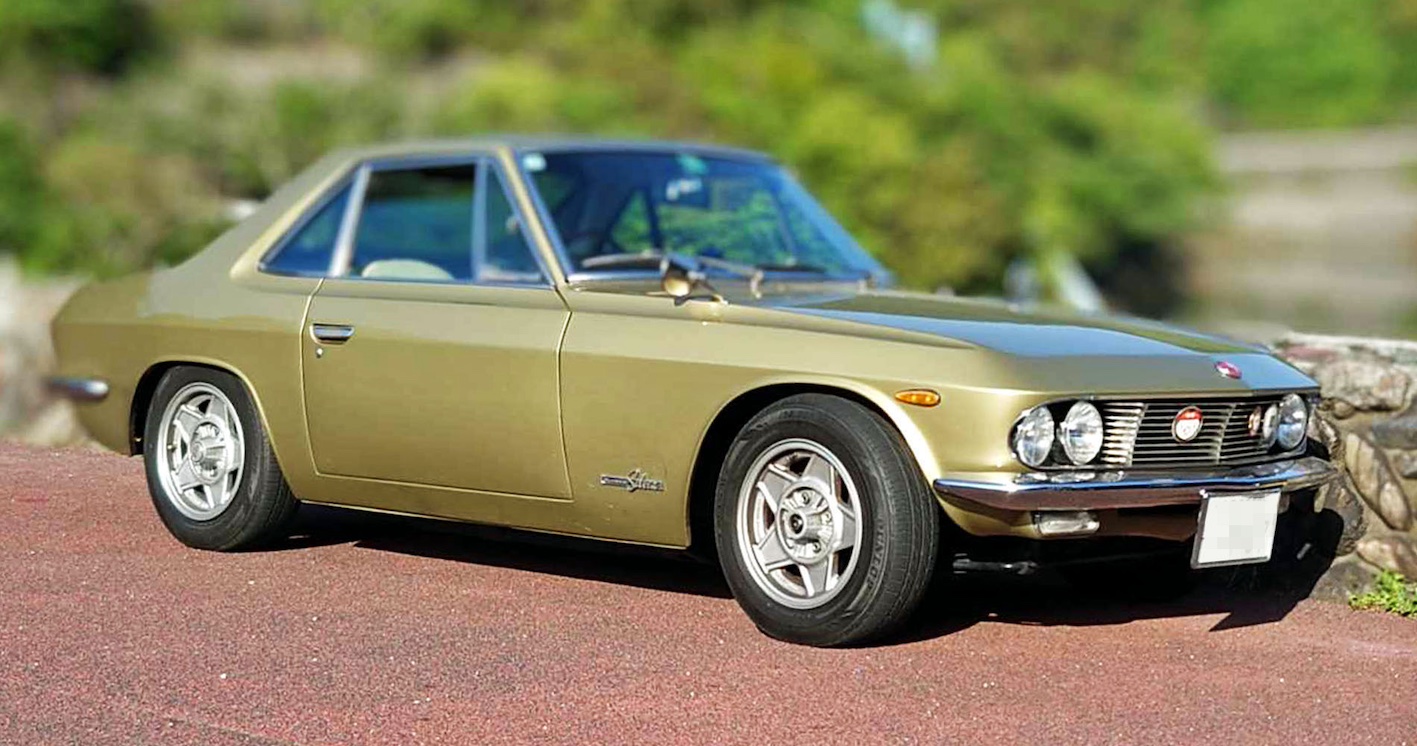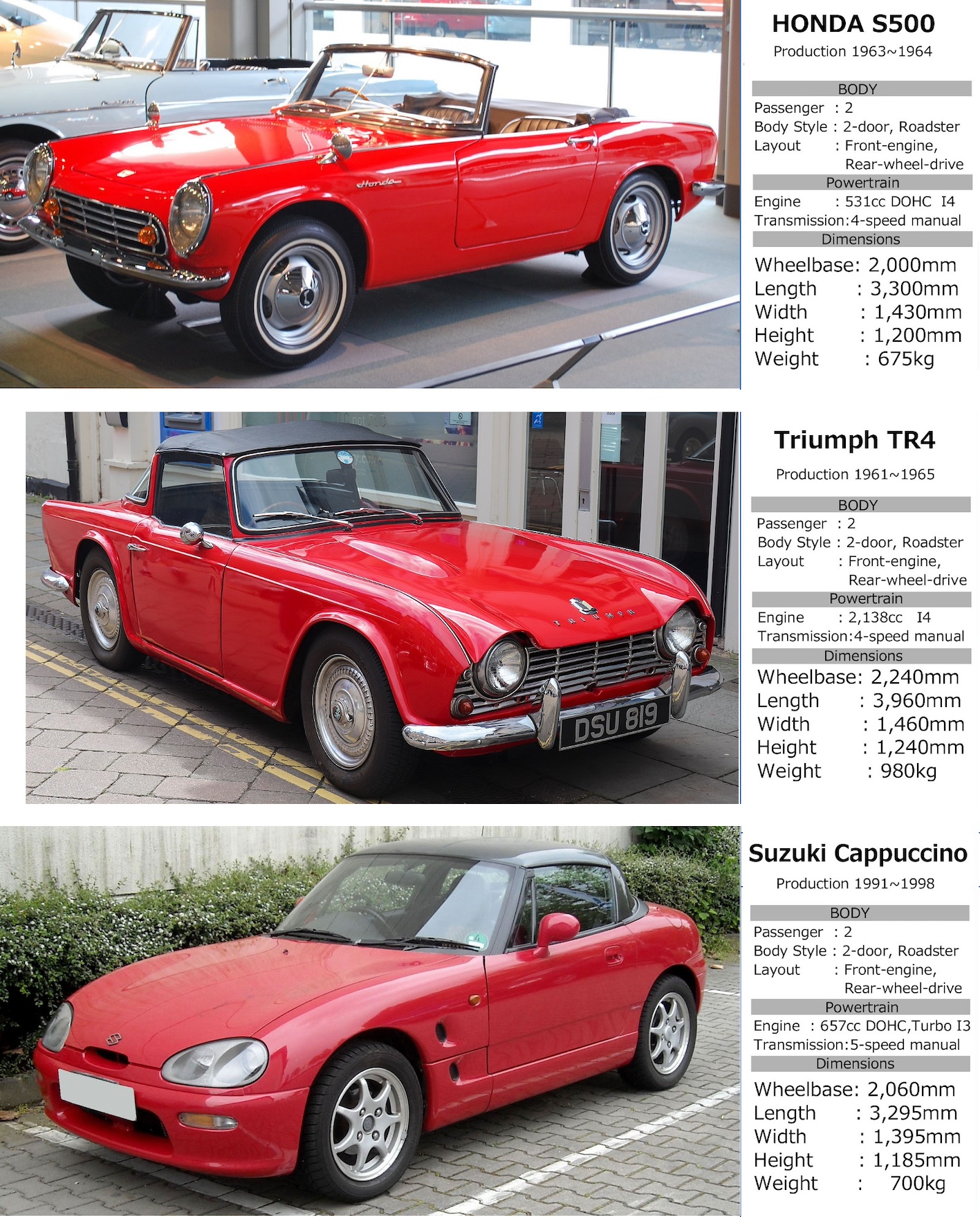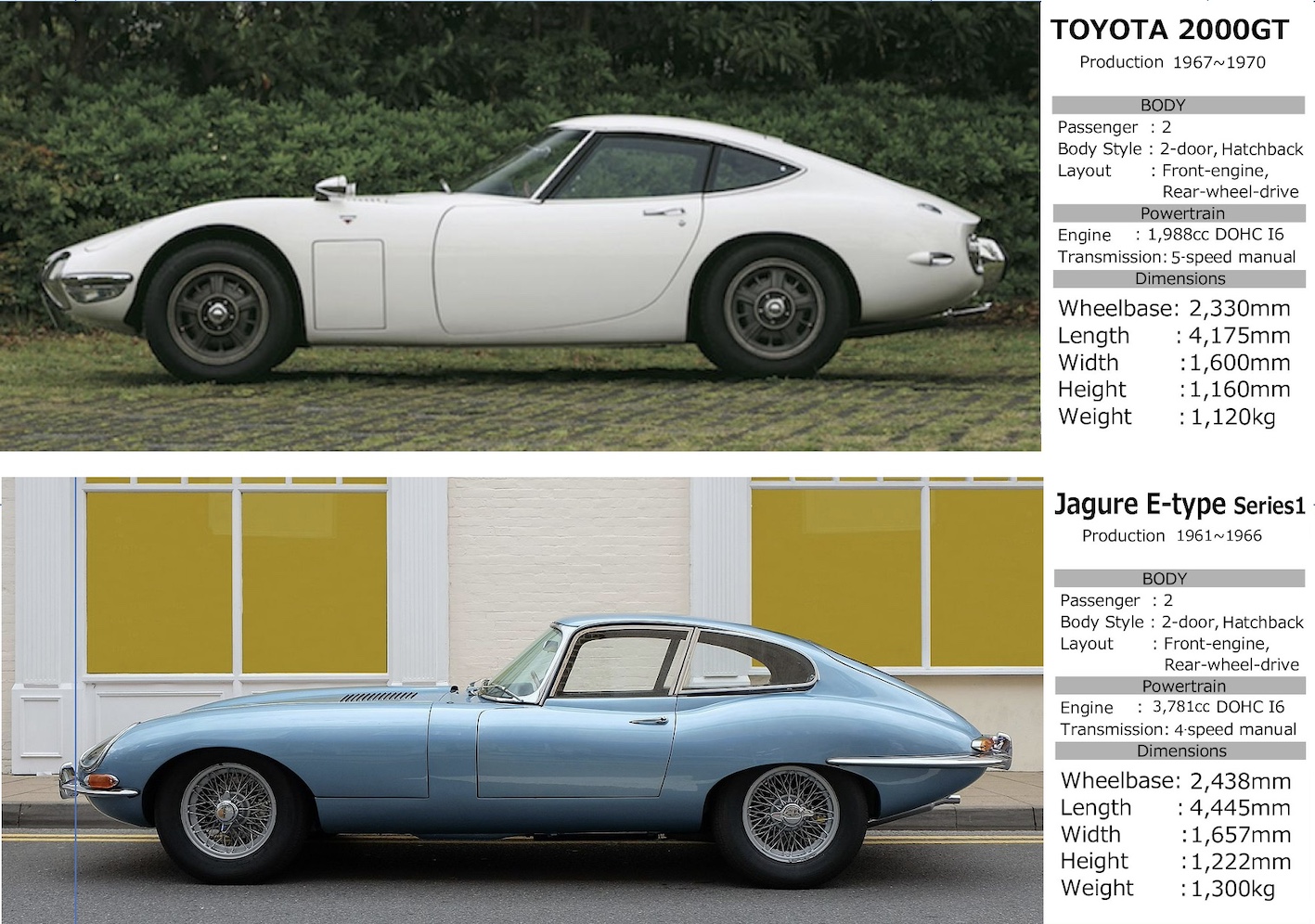日本の不思議な1960年代
60年代の米国車は、その堂々たるプロポーションとテールフィンで日本の路上では圧倒的なプレゼンスを見せ小学生だった私をワクワクさせてくれたましたが、その頃、日本のモータリゼーションはまだ黎明期でした。実用的なトラックや小型の乗用車を生産していた日本の自動車メーカーが、その60年代にとても魅力的な小型スポーツカーを作り出しました。まだまだ資金力も豊かではなく、技術の積み重ねもわずかでしかなかった日本の自動車メーカーが何故それだけのことができたのか? 本当に不思議な日本の60年代でした。 それではその不思議で魅力的なクルマ達を振り返っていきましょう。
まず先陣を切ったのは1963年式のホンダS500。それに続いて1965年にトヨタ・スポーツ800と日産シルビアが発売されます。その2年後1967年にはトヨタ2000GTとマツダ・コスモスポーツが発売されます。そして、1969年には日産フェアレディZ。この6車種はそれぞれ違ったルーフ構造を持ちますが、不思議なことに皆FR駆動形式の2シータースポーツカーでした。
まだ各家庭に1台のクルマを持つという状態にほど遠かった1960年代、購入されるクルマも実用車のみだった時代に何故日本の多くの自動車メーカーが、2シーターのスポーツカーというほとんど趣味の領域でしか語れないようなクルマを製造することにしたのかは、まったくの謎ですが、さらにその完成度が非常に高かったことは実に嬉しい驚きでした。
HONDA S500_1963
日本のほとんどの自動車メーカーは1930年代に創業されています。しかし、この魅力的なスポーツカーを最初に世に出したのは、1940年代に2輪車メーカーとして創業した後発のホンダでした。
1963年に発売されたS500(後に改良されたS600、S800が続く)。2輪車メーカーだからこそ小型スポーツカーを開発したのは頷けますが、その背景には、1961年、当時の通商産業省が自動車産業の新規参入を制限しようという動きに反して、新規参入を目指す本田宗一郎氏が再編案の成立前に四輪車の発売を行なうという英断を下したことにあります。当時二輪車のレースで欧州にも参戦し、その自動車市場にも詳しかったホンダは英国のトライアンフやロータスという小型2シータースポーツカーを参考にしたと考えられます。S500はこれらの欧州車を参考にしながら日本の道路事情を考慮して、さらなる小型化を図っていました。その寸法を1991年式の軽自動車スズキ・カプチーノと比較するとほぼ同じであることがわかります。それはS500の基本コンセプトがその前年に発表されたS360と言う軽自動車(デザインはS500とほぼ同じ) であることが大きいと言えます。

TOYOTA SPORTS 800_1965
ホンダに遅れること2年、1965年にトヨタがスポーツ800, 日産がシルビアを発売します。
後発のトヨタ、日産も欧州の小型スポーツカーを参考にしたことは想像に難くありません。トヨタは軽自動車メーカーではないのでスポーツ800も当時の軽自動車サイズではありませんが、その寸法は現在の少し大きくなった軽自動車規格にほぼ収まるほどコンパクトにまとまっています。

日産シルビア_1965
一方、同年に発売された日産シルビアは、全長がほぼ4mと、上記の2車に比べるとかなり大きくなっています。 これは初代シルビアのシャシーが4ドアセダンのブルーバード310をベースに開発されているからです。初代シルビアと言えばそのデザインがドイツ人デザイナー:ゲルツによるものとされてきましたが、近年の調査によりその基本デザインは日産のインハウスデザイナー:木村一男氏であり、そのエクステリアスケッチは1963年3月にはほぼ完成していたようです。シルビアのデザイナーは海外からか?いう議論がなされたのもこの初代シルビアのエクステリアが当時の日産車全体のデザインテイストとは一線を画するほど斬新なものだったからと思います。

TOYOTA 2000GT_1967
日本人デザイナーの活躍という点では、1967年に発売されたトヨタ2000GTがあります。
1960年代、パブリカ、コロナやクラウンという乗用車で国内市場で確かな地位を築いていたトヨタは国際市場に打って出るにあたり世界でも評価されるイメージリーダーを作るべく、おそらく社内の精鋭を集めて開発チームを結成。その時デザイン担当となったのが、野崎喩氏であったようです。今でもネットでその野崎氏のオリジナルスケッチを見ることも可能です。https://motor-fan.jp/mf/article/85638/
2000GTも英国のスポーツカーを参考にしたのは間違いなく、シャシーや駆動方式、そしてクルマ全体のプロポーションを見るとジャガーE-Typeがその教科書であったのは間違いないでしょう。
そして、2000GTの実車を見るとほとんどの人が、そのコンパクトさに驚くと思います。4mをわずかに超える全長と1200mmを切る全高、今ではちょっと議論が起こりそうなパッケージングです。

MAZDA COSMO SPORTS_1967
同じ1967年、マツダからはロータリーエンジンをイメージづけるためにコスモスポーツが発売されます。
デザインを担当したのは入社2年目の、マツダ初のインハウスデザイナー小林平治氏だそうです。
ちなみにコスモスポーツが初めて公開されたのは1963年10月の東京モーターショーで、販売開始よりはかなり早めでした。

日産FAIRLADY Z_1969
1969年には日産からは、フェアレディZ(S30)が発売されます。
このS30開発の発端は当時、米国日産の社長を務めていた片山豊氏で、北米市場拡販のために強力なイメージリーダーとなるモデルを求めていました。片山氏はジャガー・Eタイプのようなクルマを造ってほしいとの要望を出したとされており、ここでも英国製スポーツカーが当時のスポーツカーの基準であった事が窺えます。
S30のデザインは、日産自動車第1造形課・第4デザインスタジオに託された。メディアではスタジオチーフだった松尾氏作と紹介されることが多いものの、実際は吉田章夫案のファストバックをベースに松尾案のフロントマスクを合わせたデザインが基本となってな行ったそうです。

ISUZU 117COUPE_1968
まだ、日本全体の自動車保有台数が400万台程であった時代にこれほどの2シータースポーツカーが各メーカーから発売されたことは、実に不思議な事でしたが、まだ小学生であった私が、自動車に関心を徐々に寄せていくきっかけになったのは間違いありません。
そして、その60年代の魅力的なクルマ達の最後に登場したのが、唯一2シーターではなく、4シータークーペのいすゞ117クーペでした。とある道で駐車中の黄色い117クーペを初めて見た時の感動は今でも忘れないほど衝撃的でした。普通のセダンよりは少し低めのルーフラインとシャープなクーペシルエットでしたが、クルマ全体が醸し出す優雅さが今まで見たことのない程感動的でした。
117クーペのデザインは後にイタルデザインを設立するジョルジェット・ジウジアーロがカロッエリア・ギアのチーフデザイナー時代に描いたことは有名です。

決して社会背景や経済的な支えが魅力的なデザインの製品を生むとは限りません。時にはこの60年代の日本の様に明確な目標と作り手の情熱があれば、良い結果を得ることも可能であると歴史が教えてくれています。
これからデザイナーとして活躍しようと考えている皆さん、既存の方程式に囚われず、常に新しい手段で新しい目標を設定して頑張ってほしいと思います。
なお、今回の記事に添付された日本の旧車の写真の多くは、ご自身も何台かの旧車のオーナーでもある日野自動車(株)の松永栄氏のご厚意により提供して頂きました。誌面をお借りして感謝を申し上げます。
The Road to Car Designer – Part 2 – [SHIKADO’s COLUMN ] The Beginning of Japanese Car Styling
Japan’s Mysterious 1960s
The American cars of the 1960s were so impressive on the streets of Japan with their imposing proportions and tail fins that they thrilled me as an elementary school student,
At that time, motorization in Japan was still in its infancy. A Japanese automaker that produced practical trucks and small passenger cars created a very attractive small sports car in that 60s. How could a Japanese automaker, which was not yet richly funded and had only a small accumulation of technology, do such a thing? It was a truly magical time in Japan in the 1960s.
Let’s take a look back at these mysteries and fascinating cars!
First up was the 1963 Honda S500. This was followed in 1965 by the Toyota Sport 800 and the Nissan Silvia. Two years later, in 1967, the Toyota 2000GT and Mazda Cosmo Sport were launched. And in 1969, the Nissan Fairlady Z. Each of these six models had a different roof structure, but strangely enough, they were all two-seater sports cars with RWD drive systems.
It is a complete mystery why so many Japanese automakers decided to produce a two-seater sports car, a car that could only be described as a hobby, in the 1960s, when every household was far from having a car, and the only cars that could be purchased were utility vehicles. However, it was a pleasant surprise to find that it was so highly finished.
HONDA S500_1963
Most Japanese automobile manufacturers were founded in the 1930s.
However, it was Honda, a latecomer, founded in the 1940s as a two-wheeler manufacturer, that first delivered this fascinating sports car.
The S500 was launched in 1963 (later followed by the improved S600 and S800). It is no wonder that the company developed a small sports car because it is a two-wheeled vehicle manufacturer. The reason behind this development is that in 1961, in response to the then Ministry of International Trade and Industry’s move to restrict new entrants into the automobile industry, Soichiro Honda, who was aiming for a new entry, made the wise decision to launch a four-wheeled vehicle even before the government ordinance was passed.
Honda, which was racing motorcycles in Europe at the time and was familiar with that automobile market, is thought to have taken a cue from the British Triumph and Lotus, small two-seater sports cars. The S500 was modeled after these European cars and was further downsized to take into account Japanese road conditions. Comparing its dimensions to a 1991 K-car*, the Suzuki Cappuccino, shows that they are almost identical.
*K-car is Japan’s own minimal car restricted size.
This is largely because the basic concept of the S500 was the S360, a K-car (almost identical in design to the S500) that was announced the year before.

TOYOTA SPORTS 800_1965
Two years later than Honda, Toyota and Nissan launched the Sports 800 and Silvia, respectively, in 1965. It is not difficult to imagine that the latecomers Toyota and Nissan also took a cue from European small sports cars.
Toyota is not a K-car manufacturer, so the Sport 800 is not the same size as the K-cars of that era, but its dimensions are compact enough to fit into today’s expanded K-car standards.

Nissan Silvia_1965
On the other hand, the Nissan Silvia, launched in the same year, is much larger than the above two cars, with an overall length of almost 4 meters. This is because the chassis of the first Silvia was developed based on the Bluebird 310, a four-door sedan. The first generation Silvia has been attributed to German designer Goertz, but recent research has revealed that the basic design was by Kazuo Kimura, Nissan’s in-house designer, and the exterior sketches were almost completed in March 1963. The reason why there was a debate about whether the Silvia’s designer was from overseas or not was because the exterior of the first-generation Silvia was so innovative and different from the overall design taste of Nissan cars at the time.

TOYOTA 2000GT_1967
One example of the success of Japanese designers is the Toyota 2000GT, launched in 1967.
In the 1960s, Toyota, which had established a solid position in the domestic market with its passenger cars such as the Publica, Corona, and Crown, assembled an elite development team to create an image leader car that would be recognized around the world as it entered the international market. Satoru Nozaki was in charge of design at that time. Even today, it is possible to view Mr. Nozaki’s original sketches on the Internet.
There is no doubt that the 2000GT was also based on British sports cars, and the Jaguar E-Type was definitely the textbook for the chassis, drive train, and overall proportions of the car. Most people who see the 2000GT in person are surprised at how compact it is, with an overall length of just over 4 meters and an overall height of less than 1200 mm, a packaging that would be a bit controversial today.

MAZDA COSMO SPORTS_1967
Also in 1967, Mazda launched the Cosmo Sport to give an image of the rotary engine.
Heiji Kobayashi, Mazda’s first in-house designer, was in charge of the design in his second year with the company.
Incidentally, the Cosmo Sport was first shown to the public at the Tokyo Motor Show in October 1963, which was considerably earlier than the start of sales.

NISSAN FAIRLADY Z_1969
In 1969, Nissan introduced the Fairlady Z (S30). The development of the S30 was initiated by Yutaka Katayama, then president of Nissan of America, who wanted a model that would be a strong image leader to expand sales in the North American market. It is said that Mr. Katayama also requested that a car like the Jaguar E-Type be built, which again shows that British-made sports cars were the standard for sports cars at the time.
The design of the S30 was entrusted to Nissan’s Modeling Division 1 and Design Studio 4.
Although it is often reported in the media that it was designed by Matsuo, who was the studio chief, the design was actually based on Akio Yoshida’s proposal for a fastback, which was combined with Matsuo’s front mask.

ISUZU 117COUPE_1968
It was truly amazing that so many two-seater sports cars were released by various manufacturers at a time when the total number of automobiles owned in Japan was still only about 4 million, but there is no doubt that it triggered my gradual interest in automobiles, even though I was still in elementary school.
And the last of these fascinating cars of the 60s was the Isuzu 117 Coupe, the only four-seater coupe that was not a two-seater. The first time I saw a yellow 117 coupe parked on a certain street, I was so impressed that I will never forget it. It had a slightly lower roofline than a regular sedan and a sharp coupe silhouette, but the elegance that the entire car exuded was the most impressive I have ever seen. It is well known that the 117 Coupe was designed by Giorgetto Giugiaro, who later founded Italdesign, when he was chief designer of the Carrozzeria Ghia.

By no means does social background or economic support necessarily lead to attractively designed products. History has taught us that sometimes, as in Japan in the 1960s, it is possible to achieve good results if there is a clear goal and the passion of the creator.
To all of you who are thinking of becoming designers in the future.
I hope that you will not get caught up in the existing equation and always try your best to set new goals with new means.
Many of the photos of old Japanese cars included in this article were kindly provided by Mr. Sakae Matsunaga of Hino Motors, Ltd. We would like to take this opportunity to thank him.

![by Car Styling [カースタイリング]](https://motor-fan.jp/wp-content/uploads/2025/04/carstyling-jp_logo.png)




 トヨタ2000GT、トヨタ社内デザイナー野崎喩が描いた美しいフォルム【TOYOTA 2000GT物語 VOL.9】
トヨタ2000GT、トヨタ社内デザイナー野崎喩が描いた美しいフォルム【TOYOTA 2000GT物語 VOL.9】




